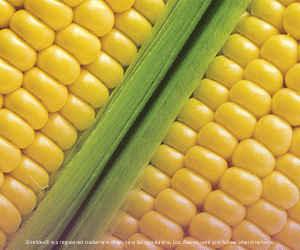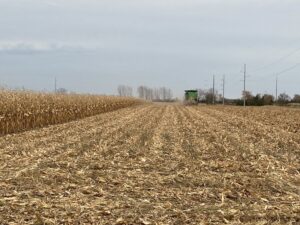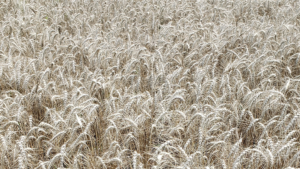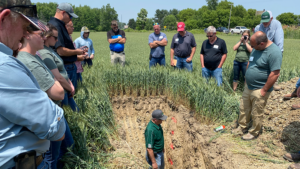Bin-busting wheat yields
TWO-TIME GUINNESS WORLD RECORD GROWER ERIC WATSON

ERIC WATSON’S TWO-TIME Guinness World record for wheat yields came with a lot of planning, testing, hard work, and luck with the weather, but the most important thing was timing.
“It’s crucial to get the timing right,” says the New Zealand farmer, who adds that goes for planting, fertilizing, and spraying. Watson farms on 490 hectares (1,211 acres) of land east of Ashburton on the country’s east coast of the South Island.
While Watson’s experience in 2017 and 2020 is quite different from growing conditions in Ontario, there are lessons that can be learned from the grower who beat his own 2017 record by harvesting 17.398 tonnes a hectare (258 bushels an acre) of wheat in February 2020.
COMPARE AND CONTRAST
Watson, who has been farming for 45 years, is a strong believer in continuous progress.
In addition to wheat, he grows grass seed (rye, timothy, red fescue, red clover) and spinach, radishes, and red beets for seed. He also grows alternative pasture species, including chicory and plantain, and he recently started hybrid canola seed production.
“We’re always trying different things,” he says.
In terms of soil, he is fortunate to have “quite a nice silt loam,” with 30 to 40 centimetres (12 to 15 inches) of topsoil and clay underneath.
“The whole farm is irrigated, and we’ve done variable rate potassium, phosphate, and lime fertilizing for 12 to 14 years now to even up the pH,” he says.
He plants wheat during the second or third week of April with sowing rates of 60 to 70 kilograms per hectare (132 to 154 pounds per acre).

“We’re aiming for 110 plants per metre squared with six to eight tillers per plant,” he says, adding that the wheat varieties are from U.K. and European breeders, where they tend to have very good tillering characteristics.
In Ontario, Joanna Follings agrees that timing is crucial, even though the seasons are opposite. “The most cost-effective way to optimize and maximize your yields is with timely planting,” says the Ontario Ministry of Agriculture, Food and Rural Affairs cereals specialist. “You can’t necessarily manage your way out of a delayed planting — you can still have good yields, but we’re finding that even with intensified management, you can’t make up for the delay.”
She strongly encourages growers to consult Ontario’s ‘Optimum Planting Date Maps for Winter Wheat.’ It outlines optimum planting date windows for each region of the province.
She adds that new research has shown that earlier planting dates result in more heads per metre squared, which Watson emphasized during a visit to North America in mid-June. He was a guest speaker during the Great Lakes Yield Enhancement Network (YEN) crop tour in Michigan.
FERTILITY
Getting nitrogen levels right is also important to produce a good wheat crop. Watson says that his fields tend to hold on to nitrogen, and it does not leach when it is wet. He applies about 300 kilograms per hectare, based on soil testing he does every year in late winter or early spring.
“We don’t want to overuse nitrogen,” he says, adding that he began using liquid nitrogen a few years ago because it achieves more even coverage than the dry version and can be spread right to the edge of the fields. He also has the advantage of a 48-metre spray boom.
“You have to be careful about timing — it’s best to apply nitrogen when it’s raining or about to rain because you can burn the leaves — it’s a bit tricky,” he warns, adding that he applies it up to five or six times during the growing season.
In Ontario, Follings agrees that liquid nitrogen is optimal, especially with the rolling topography in many areas, but that it requires the right equipment and may not be for everyone. She says splitting nitrogen applications is the way to maximize yields and minimize the potential for lodging.
Macro and micronutrients are also necessary for good yields in both countries, and tissue testing is key. For example, Watson applies 25 to 30 kilograms of magnesium per hectare and about 35 kilograms of sulphur per hectare of wheat. He regularly does tissue testing, especially for trace element deficiencies (e.g. manganese, zinc and boron) to “see what’s going on during the growing season” and adjust fertility if needed.
Follings says that growers involved in the YEN did tissue testing twice during the growing season and found that there were some nutrient deficiencies this year, such as manganese, which they were able to correct thanks to the results.
WEEDS AND DISEASE
For his herbicide program, Watson adds a pre-drilling grass weed killer, does another pass post drilling and in the pre-emergent stage. During the growing season, up to growth stage 39, the crop will be sprayed with up to five insecticides.
“We’re very susceptible to barley yellow dwarf virus, which is transmitted by aphids, which we need to get rid of,” he says.
In Ontario, fall aphid feeding can be less of a threat if planting happens within the optimum planting date window, although Follings says that following Integrated Pest Management, including regular scouting, is a good way to ward off problems.
Watson uses five fungicides throughout the season, sometimes in combination with the insecticides. His low seeding rates and aggressive spray strategy help prevent lodging, which can cause significant losses, especially in the high-yielding fields.
“It can mean two and a half to three tonnes a hectare,” he says. “It’s quite dramatic.”
Lodging can also be a problem in Ontario but can be managed by either splitting nitrogen applications or using plant growth regulators (PGR). Choosing varieties that have a low lodging score is also a good way to manage lodging, according to Follings.
“Our main diseases are yellow and brown rust and septoria, which are yield robbers as well, so control is important,” Watson says, adding that getting the spray timing right is critical.
In Ontario, fusarium is the big disease enemy, especially if the season is wet, and fungicides used appropriately can help.
Follings advises growers to monitor how the wheat crop is doing by getting into the fields and checking them out. “It’s the best way to find out the growth stage, as well as disease, weed and insect pressure,” she says. •










